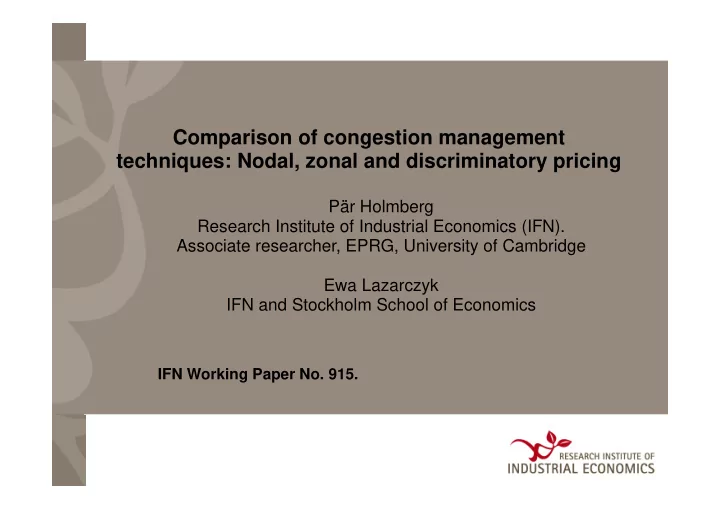

Comparison of congestion management techniques: Nodal, zonal and discriminatory pricing Pär Holmberg Research Institute of Industrial Economics (IFN). Associate researcher, EPRG, University of Cambridge Ewa Lazarczyk IFN and Stockholm School of Economics IFN Working Paper No. 915.
Congestion management How should one set wholesale electricity prices when transmission-lines are congested? Market 1 Transmission-line Market 3 Market 2
Congestion management methods 1) Zonal pricing used in most European countries. Continental Europe: normally one price per country. Scandinavia: several zones per country. 2) Nodal pricing: one price per node. Nodal pricing used in US, NZ and Russia. Poland plans to implement it. 3) Discriminatory pricing: Producers are paid as bid. Used in Iran. Partly in UK and the Nordic countries. Italy plans to implement it.
Nodal pricing Local price in every node (connection point) Price differences reflect congestion and losses. Swedish grid has roughly 100 nodes.
Nodal pricing: local marginal price Nodal demand p + net-exports Nodal supply Local marginal price: Accepted offers paid highest accepted offer. S Schweppe et al. (1988), Hogan (1992), Chao and Peck (1996), Hsu (1997).
Discriminatory pricing (pay-as-bid) Nodal demand p + net-exports Total supply in node Highest accepted offer S Payment to producers All production sold at local marginal price in competitive market with certain demand.
Zonal pricing Zonal prices. Zone’s highest accepted offer/bid sets price (local marginal pricing). Zonal clearing does not consider congestion inside zones. Redispatch/counter-trading needed Accepted counter-traded offers are paid as bid. => Zonal pricing combines marginal pricing and discriminatory pricing.
Summary of the three congestion management techniques Congestion Considered Auction format management transmission Uniform-price Pay-as-bid technique constraints Nodal All X Discriminatory All X Zonal –stage 1 Inter-zonal X Redispatch – Intra-zonal X stage 2
Arbitrage in zonal markets Zonal market neglects some congestion and countertrading market considers all congestion => predictable price differences in the two markets. Producers sell electricity in the market that is best for them. Export constrained producers (e.g. in Scotland) can sell all units at zonal price and buy it back at a lower price in the countertrade => arbitrage profit for units that are not producing. This incresase-decrease (inc-dec) game has ruined several zonal markets in US (Alaywan et al., 2004), and seems to be on-going in UK (Neuhoff, Hobbs and Newbery, 2011).
Our theoretical model General electricity network (partly meshed) with multiple nodes. General production costs Nash equilibrium of large game with many small producers that choose offers to maximize their profit. Demand is given and does not depend on the price. The market is cleared by one operator (no cross-border flows), which minimizes stated production costs. Implicit auction (electricity price includes congestion cost) Zonal pricing assumption: flows between zones are efficient (flow based).
Results All congestion management methods maximize short-run welfare. Nodal and discriminatory pricing equivalent. But zonal pricing => larger payments to producers, which can be estimated by our model. Switch from zonal to nodal pricing => Consumers gain on average. All consumers often win when a 2-node network switches from zonal to nodal pricing. Zonal pricing has long run-inefficiencies: Too much inflexible production (e.g. nuclear) running and too much investment in export constrained nodes (Dijk and Willems’, 2011; Ruderer and Zöttl, 2012; Green, 2007)
Discussion Discriminatory and zonal prices less sensitive to demand shocks compared to nodal pricing=> they improve liquidity Nodal pricing better at allocating production efficiently for fluctuating demand and supply (Green, 2010) More efficient cross-border flows with nodal pricing. (Björndal et al., 2003; Glachant and Pignon, 2005; Leuthold, 2008; Neuhoff, et al., 2011; Ogionni and Smeers 2012). Most countries, including US, started with one zone per country/state. The trend around the world is to increase number of zones in electricity markets.
Recommend
More recommend